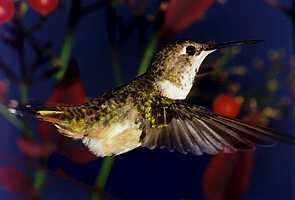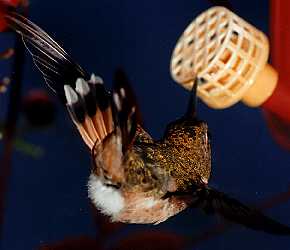 Having
enjoyed the Ruby-throated hummers for several years, secure in
the knowledge that they were the only ones east of the Mississippi,
this winter has been a real education - both in hummer knowledge
and photographic techniques. We have been leaving the feeders
up well past the fall exit of the Ruby-throats, because we had
heard that other hummers occasionally visit in the winter. A wonderful
seminar by Bob and Martha Sargent last year encouraged me to keep
trying.
Having
enjoyed the Ruby-throated hummers for several years, secure in
the knowledge that they were the only ones east of the Mississippi,
this winter has been a real education - both in hummer knowledge
and photographic techniques. We have been leaving the feeders
up well past the fall exit of the Ruby-throats, because we had
heard that other hummers occasionally visit in the winter. A wonderful
seminar by Bob and Martha Sargent last year encouraged me to keep
trying.
Well, around Thanksgiving, she (let's call her Babe) showed up. I used to think I was a pretty decent photographer for an amateur, but I had not fooled with cameras for 20 years. This past summer I'd bought a new Canon Rebel XS camera with a Sigma 70-300 macro zoom lens. So, I set it up and took what turned out to be the first of many crude attempts at catching her with natural light.
I sent the slide to Bob Sargent, who said he thought it was possibly a Rufous. Bob was too much of a gentleman to tell me that he couldn't be sure, because the slide was so bad, but I could read it between the lines. That's when I decided I had to use a flash. Well, I am now on Flash #3 and film Roll #21, and I'm not quite there yet. But the folks at Kodak, B&H, and Fast Photo Processors love me.
 Babe was still here on Christmas day. The next day we had a hard
freeze, and I knew I would never see her again. As an engineer,
I knew enough about heat transfer and energy requirements to be
sure she had frozen stiff during the night. Imagine my surprise
when she showed up - fussing very loudly when she found the feeder
frozen solid!
Babe was still here on Christmas day. The next day we had a hard
freeze, and I knew I would never see her again. As an engineer,
I knew enough about heat transfer and energy requirements to be
sure she had frozen stiff during the night. Imagine my surprise
when she showed up - fussing very loudly when she found the feeder
frozen solid!
We tried out a hair drier, which was a little hokey, but got the job done. Bob Sargent later told me I could use an ordinary flood light to keep it thawed. I'll do that next year.
In January, Bob Sargent's daughter, Donna, and Fred Bassett came and banded Babe. That was when I first saw that Babe was not drab at all. She had very beautiful colors on her back and tail. I could even see her bright green coloring through the bag Donna used to weigh her.
The thrill of holding her in my hand, and watching her suddenly come to life and fly away is impossible to describe. But the biggest thrill was when she returned to the feeder the next day, apparently unaffected by her contribution to science.
In February we took a break from hummingbirds, and went with some friends to Guntersville State Park to see the bald eagles. We were lucky enough to see a pair of nesting local eagles plus many of the wintering Michigan eagles coming in over the water at first light. I would show you a photo, but they are pretty much just fuzzy dark blobs. That trip was when I realized that I needed a really big lens. But the one I want is as big as a truck and costs as much as a house.
Back in Auburn we had another record-breaking hard freeze in February, and I knew that would be the end of Babe. I spent the day swapping five feeders between the kitchen sink and the hanger. They would freeze within just a few minutes. During that episode Babe got downright obnoxious. She would sit in the Nandina bush - fussing like the devil - until the frozen feeder was replaced with a newly thawed one.
Well, here it is halfway through March. The bluebirds are scouting my trail, the Ruby-throats are due soon, and Babe is still here. I hope she decides to leave soon, because I am not sure the natives will like her as much as I do. This morning (March 19), when she left the feeder I am almost certain that I saw her either chasing or being chased by another hummer.
[LC - Knowing the reputation of the rufous, almost certainly the former!]
A friend of mine is moving to Corvalis, Oregon in June. He is also a hummer fancier. Wouldn't it be neat if Babe showed up in his back yard this summer. I'll give him her picture, and tell him to watch for her.
Techniques for Photographs
I'm sure a lot of you already know a lot more than I do about photographing hummingbirds, but sometimes I find it easier to learn from a fellow beginner. So from this beginner, here are some of my observations. If some of them are erroneous, please let me know. I make no claims to be an expert.
 My camera is a Canon Rebel XS with a Sigma 70-300 zoom lens. At
300 mm the lens has a macro setting, which can focus to about
three feet. At four feet Babe almost fills the slide. The built-in
Canon flash works, but it was apparently designed primarily for
fill-flash, since it insisted on using a shutter speed or aperture
based on the non-flash reading. The flash I am using right now
is a SunPak 444D (about $80.00 at B & H).
My camera is a Canon Rebel XS with a Sigma 70-300 zoom lens. At
300 mm the lens has a macro setting, which can focus to about
three feet. At four feet Babe almost fills the slide. The built-in
Canon flash works, but it was apparently designed primarily for
fill-flash, since it insisted on using a shutter speed or aperture
based on the non-flash reading. The flash I am using right now
is a SunPak 444D (about $80.00 at B & H).
With that flash I can use the TTL or manual mode, and set the shutter speed at 1/90 second. I use a Canon extension, so I can mount the flash off-camera on a second tripod at about two feet, with the camera at about four feet. The flash was supposed to have a guide number of about 120, but my tests indicate that it is about two stops less than that.
One of my feeders is just outside a sliding glass door. I made a crude blind with two sheets hanging from the ceiling. This doesn't seem to bother Babe at all, but it does bother my wife when I leave the sliding glass door open in 10 degree weather. All her plants in the den died, and she claims they froze. I'm not so sure.
Well, anyway, here is what I have learned so far:
- At a 300 mm Macro setting at four feet (about life size), you need a very small aperture to get a depth of field of more than about an inch. (If you are interested in depth of field, check here for an on-line calculation of the interactions of all the variables): http://oh114.wpi.edu/cgi-bin/htdof
- But that means you need a pretty fast film, if you want to use a flash duration short enough to stop the wings.
- But using a fast film means that you may get some exposure from the natural light, which gives ghosting.
- All this means that you need a very powerful flash, or that you really need to take the pictures at night. So far Babe has not cooperated, but she does come right after first light, so I can get about 30 minutes work before the sun rises above the Red Tip Photinias.
- That early in the morning the flash pictures look like they were taken at night, so I fake it a little with a blue cardboard background. Sometimes I fake it a little more by putting the Nandina just a little closer to the feeder than where God put it. Yeah, occasionally I do take a few editorial liberties, but Babe really does frequently rest in the Nandina bush - at least when Boo Radley (the cat) is not lurking nearby.
- Automatic focus is about impossible, at least in my experience. But the manual focus on my camera is not as crisp as what I had twenty years ago on my old Konica. I wish I had bought a camera with a changeable focus screen.
- Shooting a very fast bird in near dark with a poor focusing screen and a less powerful flash than advertised and a depth of field of about an inch means that most of my pictures are pretty fuzzy and/or dark and/or ghosty and/or empty. But every once in a while I get lucky. This is actually good for the economy, because I'm doing more than my share to help Kodak survive.
- Hummingbirds, at least this one, are pretty smart. She clearly knows the difference between Boo Radley and Ringo (a fat Australian Shepherd) and Rosebud (a stupid part-Shi-tsu). The dogs don't seem to bother her in the least.
Wish List:
- More powerful flash with two slaves which can all couple with the camera's TTL meter.
- A REALLY big lens.
- A second visitor, so I would not have to wait 15 minutes before each chance to get that perfect picture
